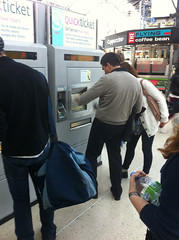HCI Diary: Observation of public transport
 At our last HCI seminar, Pejman asked us to think about commuting, public transport, and the travel experience; consider a small part of this experience, and do some observations on it. So I wandered up to Brighton station at lunchtime today, to nose around.
At our last HCI seminar, Pejman asked us to think about commuting, public transport, and the travel experience; consider a small part of this experience, and do some observations on it. So I wandered up to Brighton station at lunchtime today, to nose around.
I didn't have a clear idea of what I wanted to observe, so walked towards the station with an open mind, looking for something interesting. A few groups stood around outside (stations being natural meeting points), and as I walked past the two ticket machines at the station entrance (with a queue of 2-3 people at each) and towards the 5 machines inside the station (with at most 1 person using each), I thought I'd look at ticketing.
Some of what I saw:
- One lady walks up to the ticket machine, after a previous customer has walked away. The ticket purchase is in a half-finished state; she's obviously confused and has to look around the screen to see how to get "out" of this purchase (fix: detect when someone walks away and stop the process for them. Provide an "undo" for those times when the detection fails);
- When making a purchase, several people would not start looking for their credit card when first asked for it - introducing a delay as they went through purse and pockets (fix: see if it's possible to move the entry of credit card to the start of the process, encouraging them to have their cards ready as they queue);
- There was a common behaviour amongst many ticket purchasers, of scraping their hands along the long ticket-delivery channel towards the bottom of the machine: making sure they had all their tickets, every coin of change that had been dropped down there, etc. (fix: smaller slots for delivery of coins and tickets);
- When asking for a destination, the machine displays a keyboard on its touch-sensitive screen, and tries to help by listing all the stations which match what has been typed so far above it, and greying out keys which don't lead to a valid station name. In practice one man had trouble with this: between every key press, he would direct his gaze up, scan the list of stations, realise his wasn't on there yet, scan down, find the next letter of his station, scan up, and so on. Quite slow, and frustrated further by the lack of feedback for any successful key-press and the poor ability of the ticket machine to register key-presses (fix: some sort of feedback, visual or haptic, for a key-press; allow pressing of any key at any time, to lessen the need to glance down to keyboard? Needs more thought);

- I saw a couple of instances of two people using the machine at once, one helping the other;
- Another behaviour which popped up was queue negotiation when two machines were next to one another. Was one queue forming for both machines, or one for each? Wordless gestural conversations between queuers and new arrivals seemed sufficient to settle this one;
- About half the people I saw buy a ticket immediately headed towards the concourse, their heads up and scanning the list of departures to find theirs; why not show the next train for the ticket you've just bought on-screen?
- There's a clear and slightly frustrating delay between a customer tapping in their PIN number and receiving their ticket, whilst the ticket is printed (fix: print tickets immediately they're demanded, only hand them out once payment is approved, and accept the loss of the occasional piece of cardboard when a credit card is refused);
- I watched one guy clearly confused by the different types of ticket he could buy (I've had this myself when travelling to London), his finger hovering in the air between several different options before settling on one (fix: label tickets in ways that make sense for travellers, not rail operating companies. Maybe involve restructure of UK rail industry);